《Python编程的术与道:Python语言入门》视频课程
《Python编程的术与道:Python语言入门》视频课程链接:https://edu.csdn.net/course/detail/27845
集合(Set)
一个集合是不同对象的无序的容器。 常见用途包括成员资格测试、从序列中删除重复项、以及数学运算,如交集,并集,差集等。
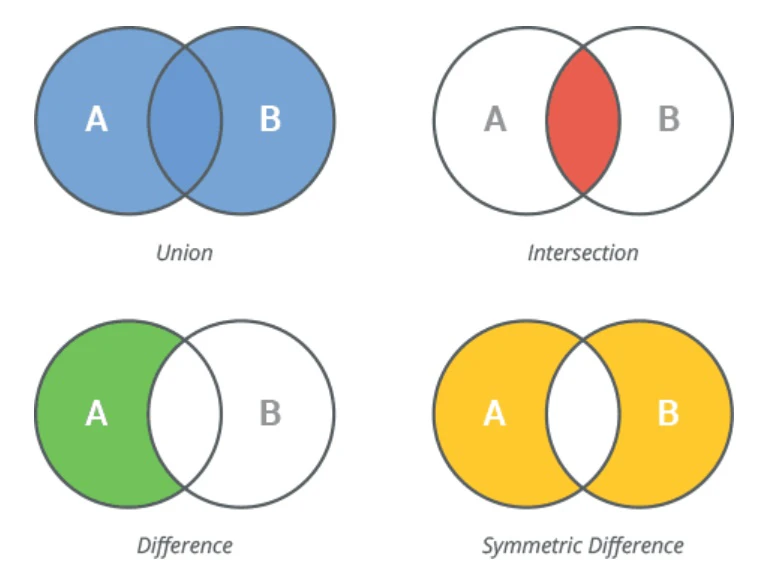
Python集合的重要属性如下:
- Sets are unordered – Items stored in a set aren’t kept in any particular order.
- Set items are unique – Duplicate items are not allowed.
- Sets are unindexed – You cannot access set items by referring to an index.
- Sets are changeable (mutable) – They can be changed in place, can grow and shrink on demand.
创建一个集合
可以通过将用逗号分隔的元素序列放在花括号{}中来创建集合。
set_of_shapes = {'circle','square','triangle'}
for shape in set_of_shapes:
print(shape)
triangle
circle
square
set_of_shapes.add('polygon')
print(set_of_shapes)
{'triangle', 'polygon', 'circle', 'square'}
集合不允许重复元素。 在创建集合时会自动将其删除。
# Example: Set removes duplicates
S = {'red', 'green', 'blue', 'red'}
print(S) # {'blue', 'green', 'red'}
{'blue', 'red', 'green'}
集合本身是可变的,但是它不能包含可变的对象。
例如:集合可以包含不可更改的对象,例如数字、字符串、元组等。
S = {1, 'abc', ('a', 'b'), True}
但是列表和字典是可变的,因此无法成为集合的元素。
# TypeError: unhashable type: 'list'
S = {[1, 2], {'a':1, 'b':2}}
---------------------------------------------------------------------------
TypeError Traceback (most recent call last)
<ipython-input-5-e6436edb64d7> in <module>
1 # TypeError: unhashable type: 'list'
----> 2 S = {[1, 2], {'a':1, 'b':2}}
TypeError: unhashable type: 'list'
集合构造函数
也可以使用称为set()的类型构造函数来创建集合。
# Set of items in an iterable
S = set('abc')
print(S) # {'a', 'b', 'c'}
# Set of successive integers
S = set(range(0, 4))
print(S) # {0, 1, 2, 3}
# Convert list into set
S = set([1, 2, 3])
print(S) # {1, 2, 3}
{'c', 'a', 'b'}
{0, 1, 2, 3}
{1, 2, 3}
将元素添加到集合
可以使用add()方法将单个元素添加到集合中。
#Example: Add ‘yellow’ to the set
S = {'red', 'green', 'blue'}
S.add('yellow')
print(S) # {'blue', 'green', 'yellow', 'red'}
{'yellow', 'blue', 'red', 'green'}
可以使用update()方法将多个元素添加到集合中。
#Example: Add ‘yellow’ and ‘orange’ to the set
S = {'red', 'green', 'blue'}
S.update(['yellow', 'orange'])
print(S) # {'blue', 'orange', 'green', 'yellow', 'red'}
{'yellow', 'blue', 'orange', 'red', 'green'}
从集合中删除元素
要从集合中删除单个元素,可使用remove()或discard()方法。
#Example: Remove ‘red’ from the set
S = {'red', 'green', 'blue'}
S.remove('red')
print(S) # {'blue', 'green'}
{'blue', 'green'}
#Example: Remove ‘red’ from the set
S = {'red', 'green', 'blue'}
S.discard('red')
print(S) # {'blue', 'green'}
{'blue', 'green'}
两种方法的工作原理完全相同。
唯一的区别是,如果指定的元素不存在于集合中:
-
remove()方法抛出KeyError
-
discard()方法什么也不做
pop()方法从集合中删除随机元素并返回它。
(The pop() method removes an arbitrary element from the set and returns the element removed.)
#Example: Remove random item from the set print returned value
S = {'red', 'green', 'blue'}
x = S.pop()
print(S)
print(x)
{'red', 'green'}
blue
set1 = set([9,4,5,2,6,7,1,8])
print(set1)
print(set1.pop())
{1, 2, 4, 5, 6, 7, 8, 9}
1
set1 = set((6,3,1,7,2,9,8,0))
print(set1)
print(set1.pop())
print(set1)
{0, 1, 2, 3, 6, 7, 8, 9}
0
{1, 2, 3, 6, 7, 8, 9}
a = set("abcdefg")
print(a.pop())
print(a)
g
{'e', 'f', 'c', 'a', 'b', 'd'}
a = set("abcdefg")
print(a.pop())
print(a)
g
{'e', 'f', 'c', 'a', 'b', 'd'}
b=set([43,54,2,67])
print(b.pop())
print(b)
67
{2, 43, 54}
如果集合为空,则pop()引发异常。
# KeyError: 'pop from an empty set'
S = set()
S.pop()
---------------------------------------------------------------------------
KeyError Traceback (most recent call last)
<ipython-input-17-152353285b12> in <module>
1 # KeyError: 'pop from an empty set'
2 S = set()
----> 3 S.pop()
KeyError: 'pop from an empty set'
使用clear()方法从集合中删除所有元素。
# Example: Empty entire set
S = {'red', 'green', 'blue'}
S.clear()
print(S) # set()
set()
得到集合大小
要查找集合中有多少元素,可使用len()方法。
#Example: Find length of a set
S = {'red', 'green', 'blue'}
print(len(S)) # 3
3
遍历集合
要遍历集合的元素,可使用for循环。
#Example: Print each item in a set
S = {'red', 'green', 'blue'}
for item in S:
print(item)
# blue green red
blue
red
green
检查元素是否存在于集合中
要检查集合中是否存在特定元素,可以在if语句中使用in和not in运算符
# Check for presence
S = {'red', 'green', 'blue'}
if 'red' in S:
print('yes')
yes
# Check for absence
S = {'red', 'green', 'blue'}
if 'yellow' not in S:
print('yes')
yes
集合操作
集合通常用于计算数学运算,例如交集,并集,差和对称差。
集合并集
可以使用union()方法或|运算符对两个或更多集合执行并集操作。
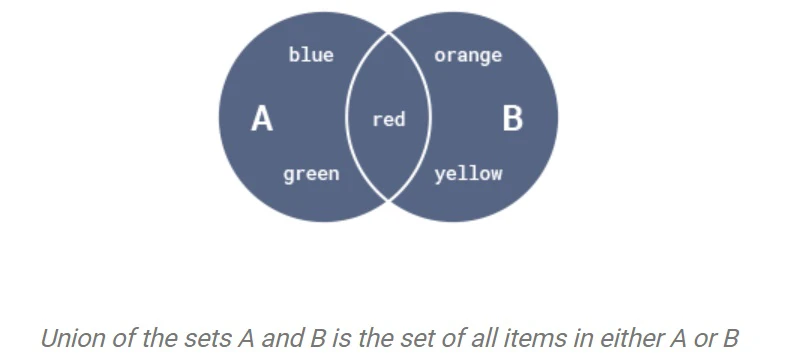
#Example:
A = {'red', 'green', 'blue'}
B = {'yellow', 'red', 'orange'}
# by operator
print(A | B)
{'blue', 'orange', 'yellow', 'red', 'green'}
# by method
print(A.union(B))
{'blue', 'orange', 'yellow', 'red', 'green'}
集合交集
可以使用intersection()方法或&运算符在两个或多个集合上执行交集。
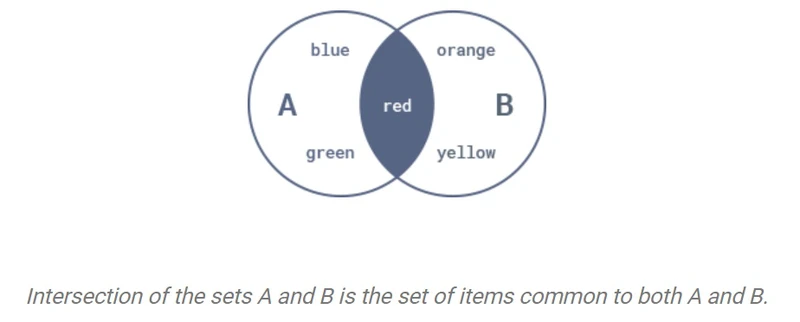
#Example:
A = {'red', 'green', 'blue'}
B = {'yellow', 'red', 'orange'}
# by operator
print(A & B)
{'red'}
# by method
print(A.intersection(B))
{'red'}
集合差集
可以使用difference()方法或-运算符来计算两个或多个集合之间的差集。
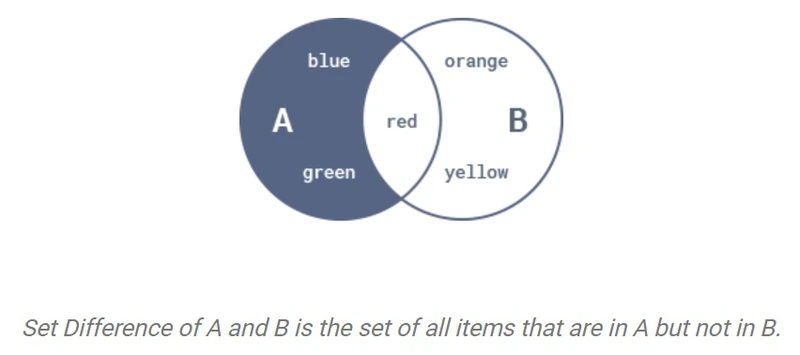
#Example:
A = {'red', 'green', 'blue'}
B = {'yellow', 'red', 'orange'}
# by operator
print(A - B)
# by method
print(A.difference(B))
{'blue', 'green'}
{'blue', 'green'}
集合对称差集(Symmetric Difference)
可以使用symmetric_difference()方法或^运算符来计算两个或多个集合之间的对称差集。
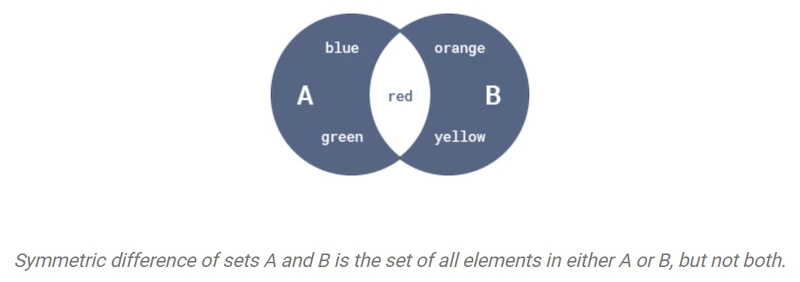
#Example:
A = {'red', 'green', 'blue'}
B = {'yellow', 'red', 'orange'}
# by operator
print(A ^ B)
{'yellow', 'orange', 'blue', 'green'}
# by method
print(A.symmetric_difference(B))
{'yellow', 'orange', 'blue', 'green'}
